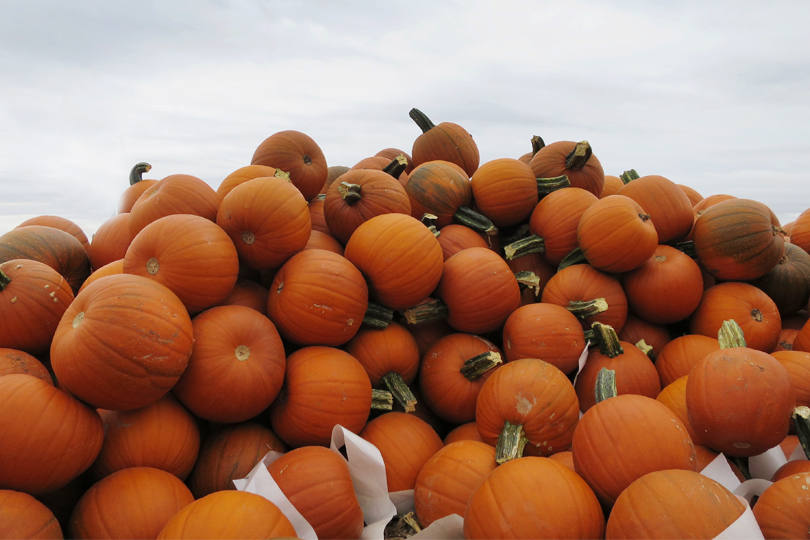Fall festivities are coming to an end, and many people wonder what to do with their decorative pumpkins and gourds.
Instead of throwing them in the trash, pumpkins can be added to a compost pile, or the seeds can be saved to plant for next year.
Some may also consider feeding pumpkins to livestock.
All livestock
Pumpkins are generally safe to feed to livestock. However, feeding a large amount of a new food to any animal may cause gastrointestinal upset or other digestive issues, so it’s best to consider it as a seasonal snack.
Paint and candlewax can be toxic, and the practice of dipping carved pumpkins in bleach introduces toxins into the flesh, as well. Pumpkins with any of these treatments should be disposed of properly.
Although some species may tolerate less-than-fresh pumpkins, it is important to not feed spoiled or rotting pumpkins due to risk of illness or disease transmission. Those pumpkins should also be safely disposed of instead of fed to animals.
It is always best to consult with your veterinarian before changing your livestock’s diet.
Cattle
Cattle find pumpkins palatable, according to Dr. Karla Jenkins, University of Nebraska-Lincoln Nebraska Extension cow-calf and range management specialist.
“Pumpkins make a good supplemental protein and energy source,” Jenkins wrote in an Extension report. “The crude protein content tends to be between 14-17% on a dry matter basis and the in vitro digestibility (similar to total digestible nutrients or TDN) is 60-70%.”
If cattle are grazing a pumpkin patch, they simply can be turned into the field to get to work munching the leftover gourds. Jenkins noted ranchers may also be able to negotiate loads of blemished or broken pumpkins prior to Halloween for an attractive price.
When feeding cattle leftover decorations as a treat, pumpkins may be set out in the pasture whole or smashed.
Horses
Horses can eat pumpkins, but only if they’re not rotting, painted or covered in candlewax, said Dr. Clair Thunes, equine nutritionist, in a recent The Horse magazine column.
One caveat is to consider the glycemic load of pumpkins before feeding too much pumpkin to horses with metabolic disorders.
Although Thunes said it can be safe to feed pumpkin to horses with equine metabolic syndrome or polysaccharide storage myopathy, it’s best to check with a veterinarian first to be sure it is appropriate for that horse.
She recommends feeding horses only one small pumpkin, or about two cups a day, per horse.
Since pumpkins are so high in potassium, she also recommends horses with hyperkalemic periodic paralysis (HYPP) not be given any pumpkin. Too much potassium can cause HYPP episodes.
Larger pumpkins should be broken into pieces before being fed to horses to avoid choking.
Poultry
Chickens, turkeys and other backyard poultry can benefit from a little pumpkin in their diet, thanks to its wide variety of vitamins and minerals.
Chickens will need pumpkins broken into smaller pieces to access the innards because they will generally not consume the rind. Owners should be prepared to collect rinds on a regular basis to prevent attracting insects and other pests.
Swine
A study conducted by Washington State University suggests pumpkins are a good treat for pigs due to their highly digestible fiber content.
The study concluded poultry and swine seemed particularly well-suited to pumpkin consumption as a large part of the diet, with all animal owners participating in the study reporting widespread and thorough consumption of pumpkin when offered to the livestock.
Pumpkins may be offered whole to swine.
Sheep and goats
Sheep and goat owners can safely feed pumpkin to their animals, too.
Sheep and goats may be fed whole pumpkins, but if they’re large gourds, it is best to smash or break them open first.


If you live out in the country and have deer on your property you can put the pumpkins out in the Woods for the deer to eat but just be sure you don’t hunt over that area because it’s illegal in Most states to hunt over a baited area. But dear love pumpkin. Also squirrels and chipmunks will eat them over the course of the winter
I have feed pumpkins for several years. Not every cow eat them, I have young calves eating them.
Love this info! I can’t tell you how many times I have thought about asking people for their leftover pumpkins for my girls (hens). Waste not, want not.
Are pumpkins also a dewormer for chickens? I’ve heard several people say that and was wondering if it was true?…
My wife purchases pumpkins, squash, sweet potatoes, yams, & carrots. Cooks them & mashes them, & adds them to our two dogs food dishes. They like the food, & the vet says they are very healthy.